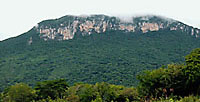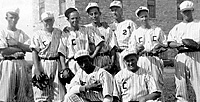A WORTHY IDEA
The formation of the Blalock Mexico Colony occurred from 1902 to 1903 with a series of events that began with an idea pursued by Mr. George E. Blalock a resident of Greer County, Oklahoma Territory. Blalock was a merchant, farmer and father of four children, three boys and a girl.
In 1902, Mr. Blalock was 47 years old and had just finished a term as sheriff of Greer County. He owned 160 acres of land and a home in Mangum. Nevertheless, Blalock continued to scrutinize real estate investment opportunities and search for land that could sustain superior agricultural production and possibly improve his financial circumstances. Mexico was being promoted as just such a place.
Mr. Blalock began exploring the potential of a plan to find land in Mexico, partner with a group of like minded Americans, and pool their economic resources to purchase a large amount of land. They would then equitably divide the property and permanently settle on it to create an American colony in Mexico.
Blalock traveled to Mexico in the spring of 1902, with his friend, Wes Ricks, to explore the possibilities. Mexico City served as his base of operations. In his search he found a tract of land north of Mexico City in the state of San Luis Potosi that seemed to measure up to his requirements: thousands of acres, diverse agricultural potential, livestock, structures, laborers and proximity to railroads. Blalock committed money to secure an option on the land while he sought enough investors to consummate the deal.
When Blalock returned to Greer County in July of 1902, he publicly shared his idea through a local newspaper. It was reported that he planned to sell all his possessions and move to Mexico. He wanted to get fifty families interested in investing with him to buy the San Luis Potosi, Mexico, land on which to settle.
Many Greer County citizens became serious enough by the prospect of "good cheap land" to send a group of men from Greer to Mexico to inspect the proposed property. They also scheduled a formal meeting for all parties interested in Blalock's proposal. At this meeting, many interested heads of families agreed to join Blalock in forming a business partnership to purchase land and colonize in Mexico. The group elected officers and heard a favorable report on the prospects of the San Luis Potosi land from the inspection committee.
A second group of Greer residents was sent to Mexico to further evaluate the proposed San Luis Potosi property and also the general atmosphere in Mexico. While these men were traveling back to Greer from their investigative trip, Blalock was closing the deal on 114, 450 acres of land in San Luis Potosi, Mexico. The tract with all improvements included crops, mills, structures, livestock and peon workers. Blalock remained in Mexico to ensure that they received clear title to the land, and it was during this process that he learned that the tract contained several thousand acres less than what had been advertised. Therefore, Blalock did not close on this tract, but continued the search for suitable property.
HACIENDA CHAMAL
While in San Louis Potosi, Blalock heard, from an acquaintance, about a promising tract of land in the state of Tamaulipas. In late September 1902, Blalock inspected the land and found it to be very suitable and a bargain as well, so he put money down on an option to secure the land.
Again Blalock published detailed information about the new tract of land in Greer County newspapers, and the business group in Greer sent another inspection team to examine the new proposed tract. When the inspection committee returned in late October 1902, they reported that the land was all that Blalock had described.
Now with suitable land secured, the group met weekly and made preparations to legally formalize their partnership by creating a stock corporation. In November 1902, they elected a board of directors and selected officers from that board. The group also adopted By-Laws and the treasurer accepted cash payments for stock that would be used to make the first payment of $30,000 on the land. Since they hoped to leave for Mexico as soon as possible, a new committee was formed to investigate travel plans, options and routes.
As there were now enough investor families, the membership of the colony was closed and others who wanted to participate were turned away. Eighty-six heads of families were members of the Blalock Mexico Colony Corporation. That title had been newly adopted as the name of their stock company.
Blalock, with other corporation officers, continued working in Mexico to finalize the purchase agreement and secure the deed to the land. They also negotiated with officials from the Mexican government for special colonization concessions.
Meanwhile, the committee in charge of travel, investigated railroad companies, compared passenger and freight rates and types of accommodations. The committee ultimately enticed the heads of ten railroad companies to come to Mangum for a meeting with the members of the corporation. At this negotiating meeting of the Blalock Mexico Colony, a rail route was selected from Mangum, Oklahoma Territory, to Escondon, Mexico, and the lowest fairs were agreed upon. Rail cars were promised to the colonists with as little as five days notice.
RED TAPE
The period from December 1902 - February 1903 marked the red tape waiting period for the colonists eager to set out for their newly purchased promise land in Mexico. Delays were caused by the need to satisfy a provision of the Mexican government's Code of Commerce. The corporation needed to obtain certified copies of all original Blalock Mexico Colony organizing documents. Those documents included the Articles of Incorporation, certified in Mangum, Territory of Oklahoma, on October 25, 1902, the Charter filed in Guthrie with the Secretary of the Territory of Oklahoma, on October 31, 1902, and corporation By-Laws. Also requisite were certified copies of the Power of Attorney for individuals acting on behalf of the corporation.
All the copies needed to be certified first in Mangum, next in Guthrie and then sent on to Washington D. C. to be authenticated by the Secretary of State of the United States and the Mexican Ambassador in Washington. Additionally, all of the original Blalock Mexico Colony organizing documents had to be translated into Spanish and certified to be true and exact copies of the original English versions. Once this had been completed, the Mexican ambassador would issue a certified statement that the corporation had been legally incorporated under the laws of the Territory of Oklahoma. Lastly, the Mexican Ambassador would send the certified copies attached with Spanish translations on to Mexico for further inspection.
Now that all of the formation work of the corporation had been completed and legalized in the United States the colonists waited for the Mexican government to certify that the Blalock Mexico Colony was a legal corporation in Mexico, and that it was legally established under the Mexican proto-colonization law of September 15, 1889, Article 24 of the Code of Commerce.
While waiting the colonists became discouraged as the early planting season came and went, and yet they were still in Greer awaiting red tape requirements to be satisfied. They hoped for the go ahead from Blalock or one of the other corporation officers in Mexico. While they waited, their time was used productively to issue company stock certificates and to select a committee to establish the colony town once they arrived on their newly purchased Chamal property.
More red tape required the colonists to purchase promissory bonds that, thankfully, would accrue interest and could be sold by the colonist once they settled on their Mexican land and met all conditions set by the Mexican government. The colonists also waited for the final duty free concession declaration from the Mexican government. They were required to make a detailed list of all of the items they intended to take with them into Mexico. The duty inspection process mandated that all items be recorded with their value and weight, both gross and net, in kilograms. Additionally, the colonists were required to go to the nearest Mexican consulate and make an emigration statement to the effect that they were moving to Mexico permanently
The story continues with Emigration


